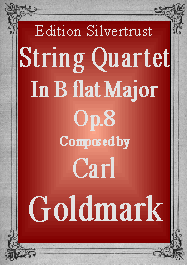Presents
Carl Goldmark
String Quartet in B flat Major, Op.8
 "Goldmark's
Op.8 String Quartet is already a mature work." So wrote the respected
critic Rudolf Felber in his article on Goldmark in Cobbett's Cyclopedic Survey
of Chamber Music.
"Goldmark's
Op.8 String Quartet is already a mature work." So wrote the respected
critic Rudolf Felber in his article on Goldmark in Cobbett's Cyclopedic Survey
of Chamber Music.
Carl Goldmark (1830-1915) was born in the town of Keszthely in Austria-Hungary. His early musical training was at the conservatories in Sopron and Odenburg. His father then sent him to Vienna where he briefly studied violin under two of the better known teachers, Leopold Jansa and Joseph Böhm. As a composer, however, Goldmark was largely self-taught. World-wide fame came to him with the performance of his opera The Queen of Sheba. He wrote in most genres and many of his other compositions, such as his Violin Concerto and the Rustic Wedding Symphony, were quite popular during his lifetime and for several years thereafter. His chamber music was well-thought of and also received concert performances while he was alive but sadly disappeared from the concert stage after his death.
Goldmark's music shows the influence of Mendelssohn and Schumann often seasoned with lively Hungarian gypsy melodies. The String Quartet dates from the mid 1860's. Wilhelm Altmann in his Handbook for String Quartet Players describes it as follows:
In Goldmark's Quartet, one immediately notices that he was a string player, in this case a violinist, as the parts he writes for all of the voices sound good and are violinistic. The opening movement has a short Andante introduction in the minor which expresses unease if not sorrow. The two themes of the main section, Allegro moderato, are happier, the first somewhat dreamy and restless, the second is pleasingly sentimental. The second movement, Andante sostenuto, is predominantly painted in sweet tonal colors until the more passionate middle section. The third movement, Allegro vivace, is a short scherzo lightly rushing forward. Of particular note is the excellent section in which the viola continues in 2/4 against the other voices in 3/4. The finale, Allegro molto, with its three themes is a fleet affair with a brilliant coda."
This is an attractive work which deserves to be heard in concert and on the stands of home music makers.
Parts: $24.95